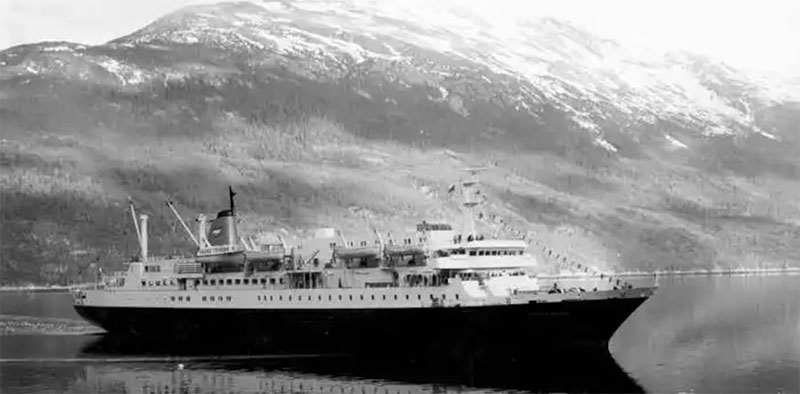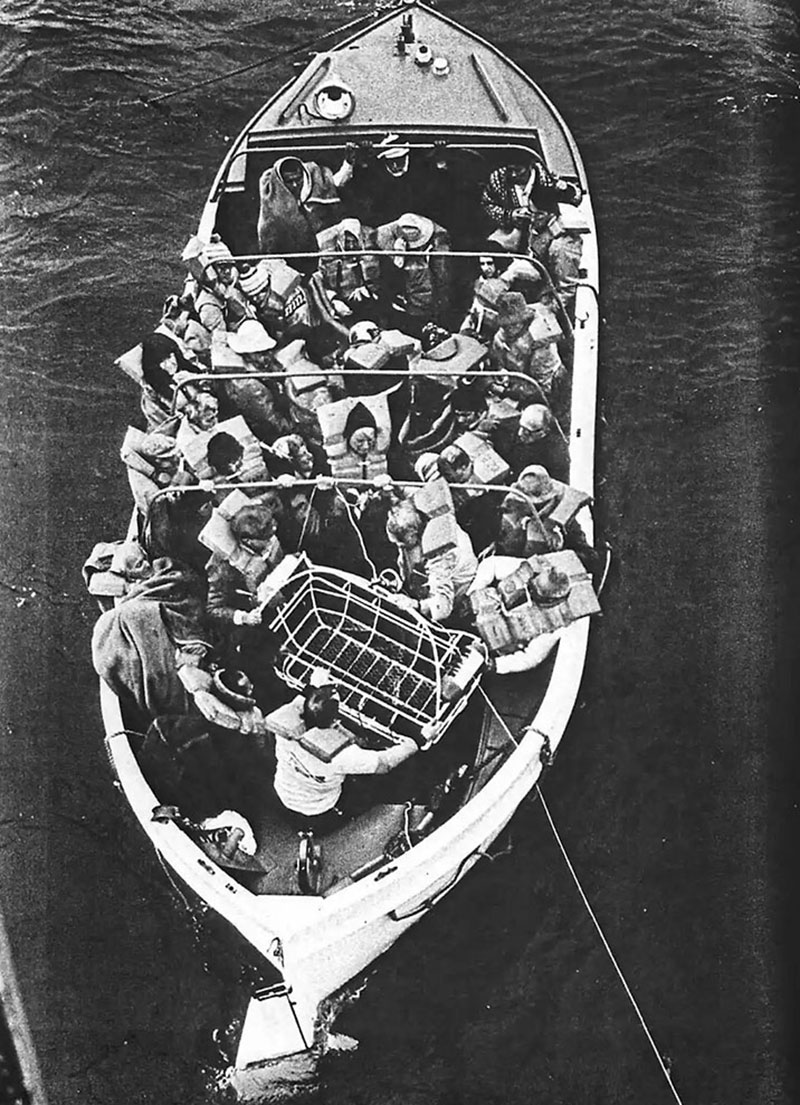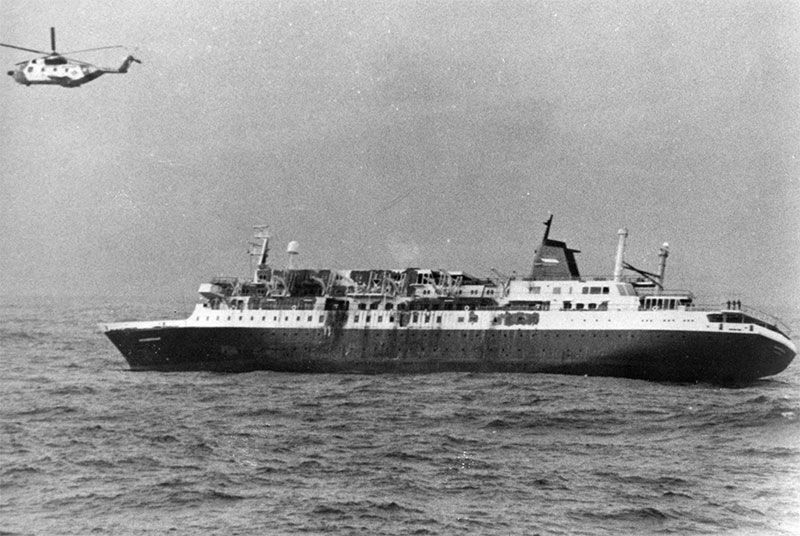Seascape Alaska 5: Gulf of Alaska Remotely Operated Vehicle Exploration and Mapping
(EX2306)
Search for Prinsendam
During the Seascape Alaska 5: Gulf of Alaska Remotely Operated Vehicle Exploration and Mapping expedition, the team will search for, and if found, explore the wreck of Prinsendam, a 427-foot cruise liner that sank off Sitka, Alaska, in 1980 after the second greatest rescue operation in the history of the United States Coast Guard (USCG). The dive will provide scientists with important information to better understand how the shipwreck and surrounding marine environment have changed over time.

The Holland-America Line began sailing in 1872, bringing passengers across the Atlantic Ocean from the Netherlands to New York City. Eighty-six percent of these passengers were immigrants beginning new lives in the United States. From these humble beginnings, the company quickly expanded into international travel, supported efforts during both World Wars, and began acquiring other businesses. Holland-America first arrived in Alaska after purchasing the locally owned Westours, Inc.
Today, Southeast Alaska attracts an average of one million cruise line passengers during the cruising season of mid-April to September. Ports like Ketchikan, Sitka, Skagway, and Juneau welcome the majority of cruisers on a variety of itineraries and ships. To better reach this market in the 1970s, the Holland-America line contracted the Merwede yard to construct its first purpose-built cruise ship, SS Prinsendam, at a cost of $27 million U.S. dollars. After a 1972 launch and subsequent sea trials, Prinsendam embarked on its first Alaska cruise on the inside passage in 1975.
After its first stop on a special cruise going from Vancouver, British Columbia, to Japan, Prinsendam left Ketchikan, Alaska, on October 2, 1980, with 524 passengers. A spark ignited a fire in the engine room during a routine fuel filter change, and the engine room quickly became engulfed. At 0058 local time on October 4, 1980, USCG Communication Stations in Kodiak, Alaska, and San Francisco, California, received the initial security broadcast reporting fire on board and quickly relayed the emergency radio broadcast to Air Station Sitka, Marine Safety Office Juneau and Rescue Coordination Center Kodiak. Sitka had their first helicopters airborne 29 minutes later, and within 45 minutes, USCG Cutter Boutwell (WHEC-719) was underway to Prinsendam’s position.
Prinsendam crew fought the fire for six hours while simultaneously calming and organizing passengers on the main deck before the call to abandon ship was made. Passengers were lowered into lifeboats just as air support from the USCG arrived. Rescue crews began transferring passengers from lifeboats to a nearby tanker, Williamsburg, and USCG Cutter Boutwell via helicopter hoists. Passengers, rescuers, and crew endured freezing conditions, 45-knot winds, and 35-foot seas. These events on October 4, 1980, amount to the second greatest rescue in USCG history, now only behind the Gulf Coast evacuations during Hurricane Katrina in 2005.
After all passengers were safely transferred, rescuers were able to extinguish the blaze and use the ship’s anchor chain to get Prinsendam under tow by the tug Commodore Straits, contracted by Holland-America and instructed to tow the smoldering hulk to Portland, Oregon. Days later, while still being towed, the cruise ship began taking on water, and eventually capsized and sank. Since the ship sank outside U.S. territorial waters, the ship’s flag country, the Netherlands, conducted the investigation. The ship has not been located or documented since.


A remotely operated vehicle (ROV) dive during the Seascape Alaska 5 expedition will offer the ocean science community an opportunity to locate the wreck and possibly provide the first look into Prinsendam’s current condition. This also provides a chance to document a unique ship type by archaeological standards: the modern cruise liner. Specific dive objectives include:
- Conduct a hydrographic survey in the last known position of Prinsendam and identify high probability targets for further assessment.
- Conduct a visual baseline archaeological documentation survey.
- Collect visual photogrammetric data for 3D photomodel processing on targeted ship features and artifacts.
- Document fire damage and evidence of rescue efforts.
The team aboard NOAA Ship Okeanos Explorer will first have to locate Prinsendam using the ship’s hull-mounted multibeam echosounder before deploying remotely operated vehicles Deep Discoverer and Seirios. Prinsendam was submitted to NOAA Ocean Exploration as a maritime heritage priority site for the 2023 Seascape Alaska Expeditions by Dr. Mike Brennan and Dr. James Delgado at SEARCH, Inc.. This effort is dedicated to the heroic efforts of servicemen and women from the United States Coast Guard, the United States Air Force, the Canadian Air Force, and supporting vessels.
By Phil Hartmeyer, Marine Archaeologist, NOAA Ocean Exploration/University Corporation for Atmospheric Research
Published September 5, 2023
Sources
Boswell, Day. “The Long Blue Line: Prinsendam-Coast Guard’s ‘Miracle Rescue’ Over 40 Years Ago!” United States Coast Guard website, April 29, 2022. Accessed Aygyst 28, 2023. https://www.mycg.uscg.mil/News/Article/3009282/the-long-blue-line-prinsendamcoast-guards-miracle-rescue-over-40-years-ago/.
Cruise Lines International Association (CLIA) Alaska. “Alaska at a Glance.” Accessed August 28, 2023. https://akcruise.org/economy/alaska-at-a-glance/#:~:text=Cruise%20tourist%20numbers%20ricocheted%20dramatically,to%20the%20region%20in%202022.
Holland America Line. “Sailing 150 Years.” Accessed August 28, 2023. https://www.hollandamerica.com/150th-anniversary/en/timeline/.
Nautilus International. “Prinsendam.” Accessed August 28, 2023. https://www.nautilusint.org/en/news-insight/ships-of-the-past/2023/march/prinsendam/#:~:text=First%20of%20many,vessels%20of%20the%20same%20design.
Netherlands Court of Inquiry. Prinsendam Fire and Loss: Transcript of Findings of the Netherlands Court of Inquiry, Session 16, 17, 18. November 1981. Translated by the United States Coast Guard Historian’s Office.
United States Coast Guard. Commandant’s Bulletin. Issue 48-80. November 24, 1980. Provided by the United States Coast Guard Historian’s Office.